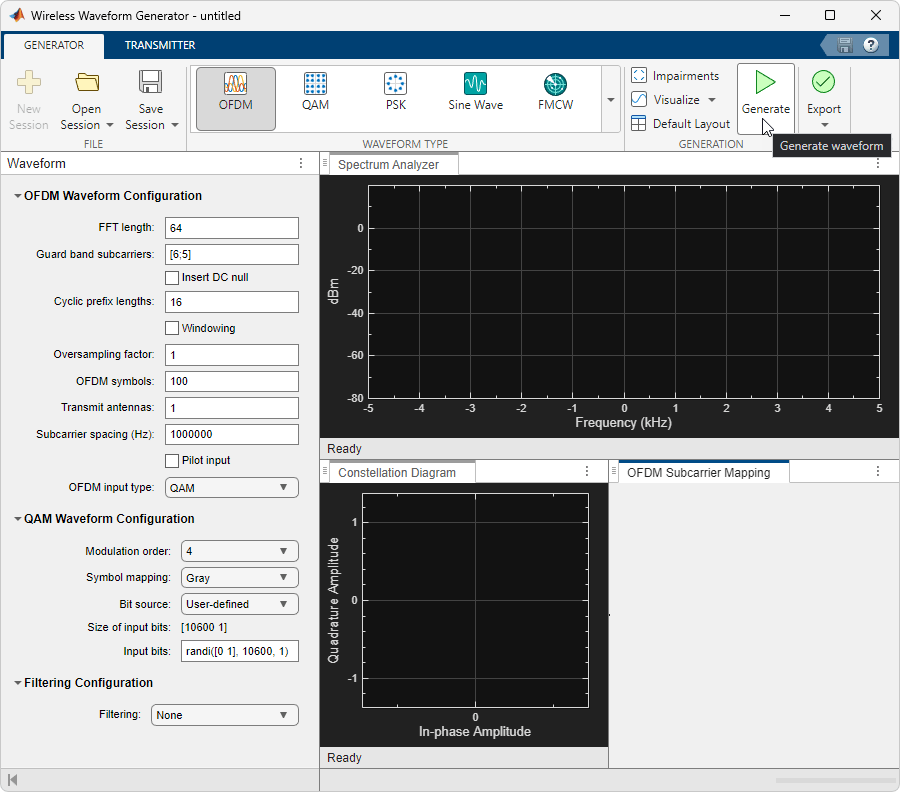LTE Waveform Generator
Create, impair, visualize, and export LTE waveforms
Description
The LTE Waveform Generator app enables you to create, impair, visualize, and export LTE waveforms.
The app provides these capabilities by using the Wireless Waveform Generator app configured for LTE waveform generation. Using the app, you can:
Generate LTE test model (E-TM) waveforms, as defined in section 6 of TS 36.141 [1].
Generate LTE downlink reference measurement channel (RMC) waveforms for user equipment (UE) performance testing, as defined in Annex A.3 of TS 36.101 [2].
Generate LTE uplink RMC waveforms for base station (BS) performance testing, as defined in Annex A of TS 36.104 [3].
Export the LTE waveform to your workspace or to a
.mat,.bb, or.txtfile.Export LTE waveform generation parameters to an executable MATLAB® script or a Simulink® block.
Use the exported script to generate your waveform without the app from the command line.
Use the exported block as a waveform source in a Simulink model. For more information, see Waveform From Wireless Waveform Generator App.
Visualize the LTE waveform in constellation diagram, spectrum analyzer, OFDM grid, 3D spectrogram, time scope, and complementary cumulative distribution function (CCDF) plots.
Distort the LTE waveform by adding RF impairments, such as AWGN, phase offset, frequency offset, DC offset, IQ imbalance, and memoryless cubic nonlinearity.
Generate an LTE waveform that you can transmit using a connected signal generator or software-defined radio (SDR).
To transmit a waveform by using a signal generator, use the Instrument Control Toolbox software and connect a supported signal generator to your computer. For more information, see Transmit Using Lab Signal Generator Instrument.
To transmit your waveforms over the air by using an NI™ USRP™ radio, use the Wireless Testbench™ software and connect a supported radio to your computer. For more information, see Transmit Signals Using Wireless Testbench Baseband Transmitter.
To transmit a waveform by using a supported SDR (ADALM-Pluto, NI USRP, or Xilinx® Zynq®-based radio), install the add-on that corresponds to your radio hardware and connect your SDR to your computer. For more information, see Transmit Using SDR.
To create, impair, visualize, and export waveforms other than LTE waveforms, you must reconfigure the app. For a full list of features, see the Wireless Waveform Generator app.
For more information, see Create Waveforms Using Wireless Waveform Generator App.
Open the LTE Waveform Generator App
MATLAB Toolstrip: On the Apps tab, under Signal
Processing and Communications, click the app icon. ![]()
MATLAB Command Prompt: Enter wirelessWaveformGenerator. This command opens
the Wireless Waveform Generator app. To
configure the app for LTE waveform generation,
in the Waveform Type section, select one of the options under LTE
(4G).
Examples
References
[1] 3GPP TS 36.141. “Base Station (BS) conformance testing.” 3rd Generation Partnership Project; Technical Specification Group Radio Access Network; Evolved Universal Terrestrial Radio Access (E-UTRA). https://www.3gpp.org.
[2] 3GPP TS 36.101. “Evolved Universal Terrestrial Radio Access (E-UTRA); User Equipment (UE) radio transmission and reception.” 3rd Generation Partnership Project; Technical Specification Group Radio Access Network. https://www.3gpp.org.
[3] 3GPP TS 36.104. “Evolved Universal Terrestrial Radio Access (E-UTRA); Base Station (BS) radio transmission and reception.” 3rd Generation Partnership Project; Technical Specification Group Radio Access Network. https://www.3gpp.org.



